
The panga, or panga seabream is a species of marine ray-finned fish belonging to the family Sparidae, which includes the seabreams and porgies. It is the only species in the monospecific genus Pterogymnus. This species is endemic to the coasts of South Africa. The panga is an important species in commercial line fisheries off South Africa.
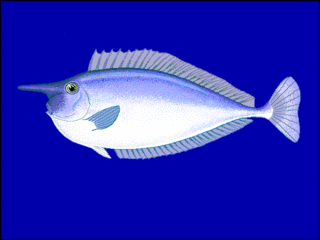
Naso is a genus of marine ray-finned fishes belonging to the family, Acanthuridae, the unicornfishes, surgeonfishes and tangs. The fishes in this genus are known commonly as unicornfishes because of the "rostral protuberance", a hornlike extension of the forehead present in some species. Unicorn fish are popular with spearfishermen and may be cooked by grilling them whole. Unicornfish primarily live around coral reefs and eat mostly algae. It is very popular in Maldives.

Acanthurus xanthopterus, the yellowfin surgeonfishyellowmask surgeonfish, ringtail surgeonfish or Cuvier's surgeonfish, is a species of marine ray-finned fish belonging to the family Acanthuridae which includes the surgeonfishes, unicornfishes and tangs. This species has a wide Indo-Pacific distribution.
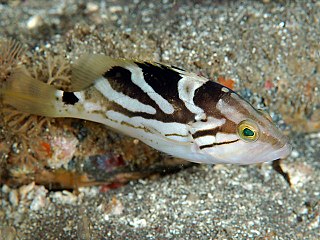
The comet grouper, also known as the comet cod or dot-dash grouper, is a species of marine ray-finned fish, a grouper from the subfamily Epinephelinae which is part of the family Serranidae, which also includes the anthias and sea basses. It is a species of deep coral reefs in the Indo-Pacific region.

The shortnose whiting is a poorly known species, described in 1989, of inshore marine fish of the smelt whiting family Sillaginidae that inhabits only the Persian Gulf. S. arabica is similar in morphology to other sillaginids, although has a distinctive shortened snout which gives the species its common name. This species is of no current interest to local fisheries, although beach seines may take minor amounts of this species.

Cephalopholis taeniops, the African hind, bluespotted sea bass or spotted grouper, is a species of marine ray-finned fish, a grouper from the subfamily Epinephelinae which is in the family Serranidae which also includes the anthias and sea basses. This species occasionally makes its way into the aquarium trade and is a target for local fisheries. It is found in the eastern Atlantic Ocean.

Acanthurus nigroris, the bluelined surgeonfish, is a species of marine ray-finned fish belonging to the family Acanthuridae, which includes the surgeonfishes, unicornfishes and tangs. This species and A. nigros have been regarded as synonymous with the combined taxon having a wide Indo-Pacific distribution, if treated as a separate valid species it is confined to the United States Pacific islands.
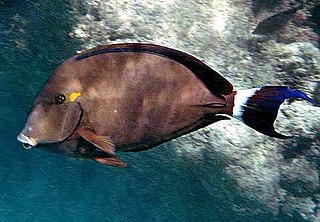
Acanthurus blochii, the ringtail surgeonfish or dark surgeonfish, is a marine ray-finned fish belonging to the family Acanthuridae, the surgeonfishes, unicornfishes and tangs. This fish is found in the Indo-Pacific.
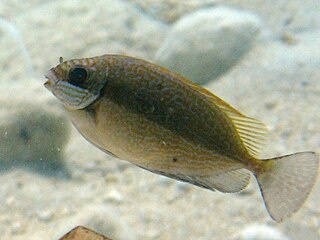
The dusky spinefoot, also known as the squaretail rabbitfish, is a species of marine ray-finned fish, a rabbitfish belonging to the family Siganidae. It is native to the western Indian Ocean which has spread to the Mediterranean Sea through the Suez Canal. Its fin spines contain venom. It is regarded as a food fish.

Leiognathus is a genus of marine ray-finned fishes, ponyfishes from the family Leiognathidae. They are native to the Indian Ocean and the western Pacific Ocean. They are sometimes known as silverbellies.

Apsilus is a small genus of marine ray-finned fish, snappers belonging to the family Lutjanidae. The two species within the genus are native to the Atlantic Ocean,
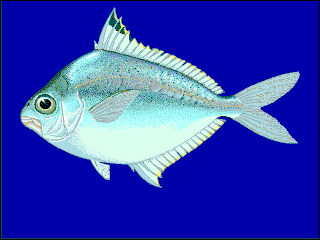
Eubleekeria splendens, common names splendid ponyfish and blacktip ponyfish, is a species of ponyfish.

The golden-lined spinefoot, also known as the goldlined rabbitfish or lined rabbitfish, is a species of marine ray-finned fish, a rabbitfish belonging to the family Siganidae. It is found in the tropical Western Pacific and along the coasts of northern Australia.

Leiognathus longispinis, commonly known as the longspine- or Smithurst's ponyfish, is a fish of brackish and marine waters found in the Indian and western Pacific Oceans, from India through Malaysia and Indonesia south to northern Australia and east to the Philippines and Fiji It was described in 1835 by French Zoologist Achille Valenciennes from a specimen caught off Waigeo island in Irian Jaya in New Guinea. In 1886 Ramsay and Ogilby described what turned out to the same species from Hood Lagoon in Papua New Guinea, naming it Leiognathus smithursti. In 2008, ichthyologists Prosanta Chakrabarty and John S. Sparks resurrected the genus Aurigequula and placed L. longispinis and L. fasciatus in it, on the basis of a horizontal row of yellow markings on their flanks and elongated second spine of the dorsal fin. However, a molecular study showed that the genus Leiognathus was nested within Aurigequula, and hence the genera were merged once more. Fishbase places this species in Leiognathus while retaining the striped ponyfish in the monotypic Aurigequula.

Equulites elongatus, the slender ponyfish, also called the elongate ponyfish, elongate slimy or elongated slipmouth, is a marine fish of the family Leiognathidae native to the western Pacific and Indian Oceans.

Leiognathus berbis, the Berber ponyfish, is a species of marine ray-finned fish, a ponyfish from the family Leiognathidae. It is found in brackish and marine waters in the Indian and Pacific Oceans from the Red Sea, Gulf of Aden and Zanzibar east in the Indian Ocean to south-east Asia. Like its relatives, the fish is a demersal species that feeds on small crustaceans and bivalves. Equula berbis is considered by some authorities to be nomen dubium with the taxon it is assigned to being of uncertain placement beyond the family level, the name being thought to probably be a junior synonym of Equulites oblongus.
Equulites klunzingeri, or Klunzinger's ponyfish, is a marine, demersal species of ponyfish from the family Leiognathidae which was originally found only in the Red Sea. It is colonizing the Mediterranean as part of the Lessepsian migration through the Suez Canal.
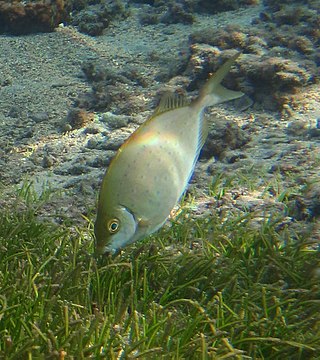
Siganus sutor, the shoemaker spinefoot rabbitfish ,whitespotted rabbitfish or African whitespotted rabbitfish, is a species of marine ray-finned fish, a rabbitfish belonging to the family Siganidae. It lives in Indo-Pacific coral reefs. It is endemic to the Indian Ocean, from Indonesia to Comoros. S. sutor is one of the commercial marine fishes, which is ubiquitously caught, in Tanzania and the entire East African coast of the Indian Ocean. S. sutor is among the most common fish species in the marine fisheries of Kenya, and accounts for around 40% of the artisanal fishery landings. Various fishing gears are used to target the siganids, but basket traps are the preferred ones. It is one of the mangrove/seagrass-associated coral reef fishes. This species inhabits littoral areas and its fin spines are venomous to humans.
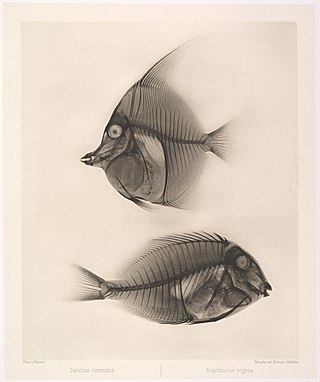
The grey-head surgeonfish is a species of marine ray-finned fish belonging to the family Acanthuridae which includes the surgeonfishes. unicornfishes and tangs. This species has a wide Indo-Pacific distribution.
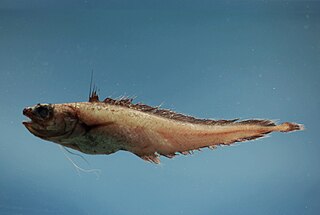
The short beard codling is a species of marine bony fish in the family Moridae. Native to the western Atlantic Ocean, it is found on the continental slope at depths between 50 and 1,620 m.



















